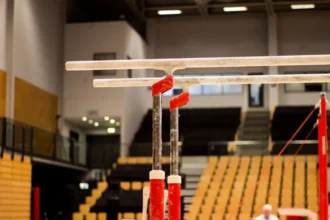If your gymnast is moving through the USA Gymnastics Development Program, you’ve probably heard the phrase “scoring out.”
It is gymnastics shorthand for earning the minimum mobility score at a USAG-sanctioned, live meet, which allows a gymnast to advance to the next level without completing an entire season at their current level.
According to USA Gymnastics Rules & Policies, athletes may only advance one level at a time, and they must achieve the required All-Around (AA) mobility score at a sanctioned competition to do so.
Key Point: Mobility must be achieved at a live, in-person sanctioned meet. Scrimmages, in-gym evaluations, practice meets, and virtual events do not count.
The Current “Score-Out” (Mobility) Numbers
USA Gymnastics publishes an official age/entry and mobility chart each year in its Rules & Policies. Below is the portion most families look for Levels 4–10. These are the minimum All-Around (AA) scores required to move up, unless noted as IES (Individual Event Specialist) in the optional levels.
| Level | Minimum Age | Move-Up Requirement (to next level) |
|---|---|---|
| 4 | 7 | 34.00 AA to move to Level 5. OR two 36.00 AA at Level 4 to skip Level 5 and enter Level 6. |
| 5 | 7 | 32.00 AA to move to Level 6. May move back and forth between 5 and 6. May be skipped if two 36.00 AA were achieved at Level 4. |
| 6 | 7 | 32.00 AA to move to Level 7. May be skipped if 32.00 AA was achieved at Level 5. |
| 7 | 7 | 32.00 AA to move to Level 8. OR 8.50 IES score (per-event) for mobility. |
| 8 | 8 | 34.00 AA to move to Level 9. OR 8.50 IES score (per-event). |
| 9 | 8 | 34.00 AA to move to Level 10. OR 8.50 IES score (per-event). |
| 10 | 9 | Top of the Development Program ladder. No further mobility scores. |
At the compulsory levels (4–5), gymnasts need higher AA scores to demonstrate readiness. At the optional levels (6–10), the AA cutoffs are slightly lower, but there’s also the IES option for event specialists.
AA vs. IES: How “Scoring Out” Works in Practice
AA Path
For most gymnasts, the All-Around (AA) path is the standard route. If the gymnast achieves the required AA mobility score at a sanctioned meet, she may advance to the next level as a full AA competitor. This means training and competing on all four events—vault, bars, beam, and floor—at the new level.
IES Path (Levels 7–9)
The Individual Event Specialist (IES) path works differently. A gymnast can earn mobility by scoring 8.50 or higher on a single event. This qualifies her to compete that event at the next level, even if she doesn’t meet the AA requirement.
IES also plays a role in the championship pipeline:
- At State or Regional meets, gymnasts must designate their IES events in advance.
- Once designated, they may only compete on those events at that meet—they cannot switch to non-designated events.
- This rule ensures fairness when comparing event specialists to AA gymnasts.
The AA path keeps all doors open, from full competition to college opportunities. The IES path offers flexibility for gymnasts with standout events, injuries, or weaker apparatuses, but it carries limitations at higher-level meets.
What About Xcel → DP and Other Entries?
Athletes don’t automatically “score out” of the Xcel Program into higher Development Program levels. By default, a gymnast transitioning from Xcel—or from another system—enters the DP at Level 4, unless a petition is formally approved by USA Gymnastics.
This ensures consistency and verifies that gymnasts meet DP standards before moving up.
State Variations
Some states add local requirements. For example, a state might require gymnasts to:
- Score out of both Level 4 and Level 5 before competing at Level 6 or 7.
- Meet mobility scores at multiple meets rather than just one.
Always check your State Administrative Committee Chair (SACC) page for the most up-to-date guidance.
Xcel Mobility Within Xcel
Mobility also exists within the Xcel Program. For example, moving from Platinum → Diamond → Sapphire requires gymnasts to hit qualifying scores. Starting in the 2025–26 season, upper-level Xcel divisions (Platinum, Diamond, Sapphire) require two-judge panels at mobility or qualifying meets—bringing them closer to DP judging standards.
If your gymnast moves from Xcel into DP, she will almost always begin at Level 4, unless a coach successfully petitions for higher placement. Once in DP, she must follow the same score-out process as everyone else.
How Many Meets Are Needed to “Score Out”?
In most cases, just one live, USAG-sanctioned meet is enough to earn the AA mobility score. Once achieved, the gymnast is eligible to advance.
Key Exceptions
- Skipping Level 5: To bypass Level 5 and move directly from Level 4 to Level 6, a gymnast must compete in two sanctioned Level 4 meets and earn 36.00 AA or higher at both.
- State or Local Rules: Some states may add meet minimums or timing restrictions. Always confirm with your coach and SACC.
Example: If a gymnast competes one Level 6 meet and earns a 32.00 AA, she is officially eligible for Level 7. No second meet is required—unless she’s skipping a level under an exception.
Common Pathways (Realistic Scenarios)
Scoring out shapes real competition journeys. Here are a few common routes:
New to Compulsories (Starting at Level 4)
- Path: Earn 34.00 AA at Level 4 → Compete Level 5.
- Skip Option: Earn 36.00 AA twice at Level 4 → Enter Level 6 directly.
This prevents advanced gymnasts from repeating compulsory routines unnecessarily.
Level 5 to 7 Quickly
- Path: Earn 32.00 AA at Level 5 → Skip Level 6 and enter Level 7.
- Coach’s Role: While allowed, many gyms weigh skill depth and meet readiness before skipping Level 6. Some treat Level 6 as a valuable “practice optional” year.
Optional Progression with IES
- Scenario: A gymnast is excellent on bars but recovering tumbling skills. She may use the IES path by scoring 8.50 on bars to move up on that event while still training to regain AA readiness.
- Advantage: Keeps progress moving forward without being held back by one apparatus.
Frequently Asked Questions About Scoring Out
Does a scrimmage count?
No. Mobility must be earned at a live, USAG-sanctioned competition.
If we took a season off, can we return higher?
Yes. If the gymnast previously achieved the minimum mobility score, she may move up one level after time away, with SACC approval.
Can we switch between Level 5 and 6?
Yes. Mobility back and forth between these two levels is allowed. Coaches often use Level 6 as a transitional “practice optional” year before Level 7.
Who decides IES vs. AA at championships?
- IES qualifiers must designate their events in advance and may not compete outside those events at State/Regionals.
- AA qualifiers automatically compete on all four and don’t need to designate.
Sources (official & practical)
- USAG Women’s Rules & Policies (2024 edition)
- 2024–25 & 2025–26 program updates
- State example (Kentucky)
- Community explanation






